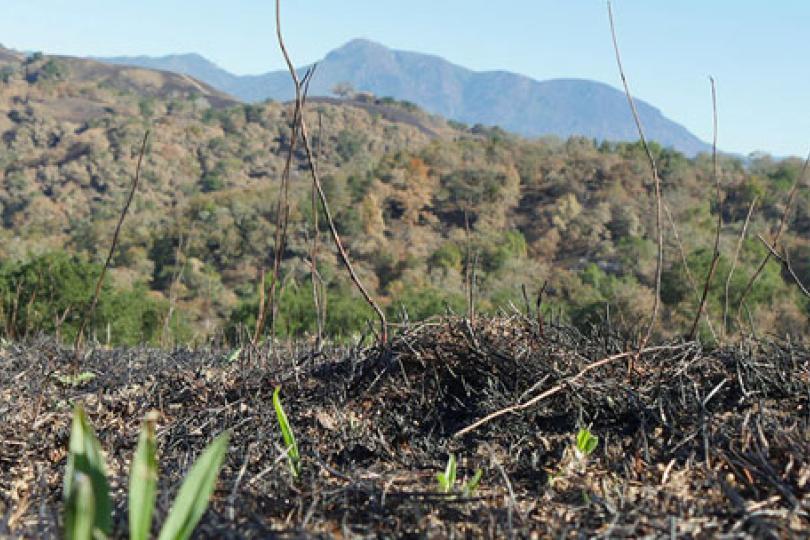At Santa Rosa's Pepperwood Preserve, nature rebounds from massive wildfire
Editor's note: The following story first appeared in The Press Democrat. Switzer Fellow Lisa Micheli is President and CEO of the Pepperwood Foundation, which operates the Pepperwood Preserve.
Green stalks of redwood lilies grow beneath the giant trees at Pepperwood Preserve, but no one has seen the colorful, trumpet-shaped blossoms in decades.
They likely haven’t bloomed since 1964, when powerful winds pushed the Hanly fire from Calistoga to Santa Rosa, following much the same path of the deadly Tubbs fire three weeks ago. Both blazes scorched a broad swath across the 3,200-acre preserve in the Mayacamas Mountains northeast of Santa Rosa.
Redwood lilies are a fire-dependent species that require wildfire heat to reproduce, said Michael Gillogly, the preserve manager, who lived on the property for 23 years. His was one of two homes on the preserve destroyed by the conflagration that wiped out nearly 7,000 Sonoma County dwellings.
“I can’t wait to see them,” he said.
The redwood lilies fit well in Pepperwood’s rugged landscape, evolved over thousands of years not only to survive but to thrive in the Mediterranean climate of the Coast Range, where oak, fir and redwood forests, shrubs and grasslands are baked dry every summer, vulnerable to natural or human ignition.
“There is beauty in the Pepperwood landscape now,” said Lisa Micheli, president of the foundation that operates the facility located off Porter Creek Road. “It is in a renewal process.”
The property, which includes the headwaters of three creeks that flow into the Russian River, is home to 750 varieties of native plants and 150 species of wildlife, including birds, reptiles and mammals.
The fire also wrought a significant new direction for Pepperwood’s role as a scientific research facility, “perfectly positioned,” she said, to document wildland fire recovery and possibly to develop new strategies for forest management and firefighting.
“Even save lives,” Micheli said.
There is little green to be seen on the hillside around Pepperwood’s headquarters, the concrete-walled Dwight Center built to withstand fire and now dubbed “The Bunker” because it came through the Tubbs fire with only minor smoke and soot damage inside.
Bony black fingers of chaparral protrude from scorched bare earth, appearing toasted now but expected to soon sprout green shoots from their roots and begin regrowth. Dense thickets of chaparral provide safe nesting places for birds, cover for jackrabbits and birthing places for deer, Gillogly said.
Farther uphill, oak and Douglas fir trees stand with singed and drooping leaves and a less certain prognosis. The only way to tell if a mature tree is dead is to cut through the bark to the cambium layer, which transports water and nutrients up from the soil, he said.
If the layer is destroyed all the way around, the tree will probably die, but Pepperwood is not considering that appraisal.
“We’ll just wait and see what greens up in the spring,” Gillogly said.
Frankly, the preserve wouldn’t mind losing some firs, which invade oak woodlands and grow faster, eventually cutting off sunlight and dooming the oaks, Micheli said. Cutting out small fir trees has been one of the preserve’s forest management strategies, which has the added benefit of reducing fuel content for fires, she said.
In the absence of a thorough survey, Pepperwood officials assume much of the preserve’s 900 acres of grasslands were burned. But they know, based on the aftermath of controlled burns intended to eliminate invasive grasses and serve as fire breaks, that the meadows will fill again with green grass and wildflowers.
On their few visits to the land, Pepperwood staffers have seen a coyote, foraging deer and a bevy of quail. Gophers are at work restoring their burrows, reseeding grasses in the process by pushing their underground food stores of seed to the surface.
Pepperwood staff have mixed feelings about proclaiming the ecosystem’s gains in the face of such raw tragedy, including 43 deaths, from the North Bay fires. Micheli said the devastation she saw along the Mark West area on her first post-fire visit “almost made my heart stop.”
Pepperwood lost two homes, a barn full of equipment, water and power facilities and an observatory that featured a brass telescope built in the 1870s.
Gillogly made a narrow escape from the flames the night of Oct. 8 when the fire assaulted Pepperwood from two directions, running up Franz Valley from the east — where it started near Calistoga — and coming from the south up the hill from Porter Creek Road.
The fire’s burn pattern was “eerily similar” to the Hanly fire a half-century ago, he said.
Four years ago, Gillogly stood on an east-facing slope that the Hanly fire had roared up almost 50 years earlier, and predicted that one day fire would come from the same direction and be the most destructive fire in California history. That’s a designation now granted to the Tubbs fire.
“All it needs is an ignition source,” he said then. “It could burn any time.”
And it could happen again in the future, he said last week, given the same ominous conditions of wind force and point of origin. “We live in an ecosystem designed to burn,” he said.
Pepperwood, which had focused research on forest survival in the face of climate change, has added fire science to its mission, Micheli said.
The preserve’s bucolic landscape is studded with more than 200 sensors and meters that record weather — temperature, wind, humidity and barometric pressure — as well as water coming down as rain and fog drip and going out as flow in ephemeral streams and soil moisture. New meters will be added to measure stream turbidity or murkiness from post-fire erosion.
There are also 24 wildlife cameras, and one of the staff’s top priorities is to get out in the field, as soon as it is safe, to check the condition of all the devices, said Celeste Dodge, Pepperwood’s systems ecologist.
Thanks to the hardware, Pepperwood has five years of baseline data that will be compared with similar measurements as the landscape recovers.
Micheli said it is an “incredible opportunity” to understand fire behavior in the Coast Range, which may inform firefighting strategies and assess forest management tactics, such as controlled burns and reducing tree density.
“We are in a drier and more fire-prone environment,” she said, referring to climate change and noting the trend will continue as long as carbon emissions continue.
What happened at Pepperwood — including survival of the $9 million Dwight Center, built into the hill with an eight-foot gap between the structure and the soil — may also shape rebuilding of structures throughout the North Bay.
“Should we really be building our homes out of super-flammable materials?” she asked. “I hope we can think out of the box.”

